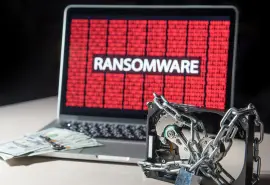Being the target of a ransomware attack and losing access to important files is stressful. It is normal for ransomware victims to feel helpless. But victims still have options. Secure Data Recovery is the leader in ransomware data recovery. Our experts can identify, analyze, and restore encrypted files from storage devices infected with this type of malware. We research and develop sophisticated tools to counter cybercriminals. Our proven disaster recovery services reduce data loss and downtime.
How Ransomware Works
Ransomware is malicious software that prevents victims from accessing their files or threatens to release personal data unless a financial demand is met. Here is a primer on how ransomware works:
Hackers have multiple methods of delivering ransomware to a victim. Exploiting vulnerabilities within software, launching brute-force attacks, and sending phishing emails are the most common vectors.
Once delivered, the ransomware infects the victim’s computer. It often gains administrative privileges from the computer’s operating system, such as Microsoft’s Windows or Apple’s macOS. These privileges allow cybercriminals to lock the computer system or restrict access to files.
The ransomware encodes the victim’s data using an encryption algorithm. The process converts files into an unreadable format that can be decoded with a decryption key.
After encrypting the victim’s files, hackers leave a ransom note. The ransom note often creates a line of communication and provides payment instructions. The note also warns of permanent data loss if the payment (typically through cryptocurrencies like Bitcoin) is not received on time.
A majority of cybersecurity specialists do not advise paying the ransom. Victims might never receive the decryption key. Cybercriminals might demand additional payments for a full recovery. Errors while creating the encryption and decryption keys might also corrupt the data. Even if paying the ransom returns the original files, it might encourage future cyberattacks.
How To Prevent Ransomware Attacks
Preventing ransomware attacks is a matter of being cautious, flexible, and prepared. Users cannot just account for current variants. Users must also prepare for emerging dangers. When it comes to ransomware, IT teams should be proactive instead of reactive and up to date with the latest CISA and NIST resources. An ounce of prevention is worth a pound of cure. Everyone should be aware of the incident response plan and it should be frequently practiced and updated to reflect the evolving landscape.
These four tips can mitigate the risk of ransomware:
Tip 1: Use Incremental or Immutable Backups
An incremental backup archives data that has been created or changed since the previous save. Incremental backups occur at specified intervals. An immutable backup features storage devices with write protection. That means its data cannot be modified after the initial write.
Tip 2: Observe the 3-2-1 Rule
Regardless of the backup strategy, following the 3-2-1 Rule is recommended. The 3-2-1 Rule refers to the practice of storing three copies of important data on two different devices and duplicating one set of files offsite. The practice prevents all copies from being encrypted.
Tip 3: Recognize Endpoints
Knowing what malicious actors might target can be helpful. Categorize all endpoints and prioritize protecting the most vulnerable ones.
Tip 4: Implement Stronger Measures
Additional measures, such as multi-factor authentication, zero-trust framework, and cybersecurity education for employees, can prevent devastating ransomware attacks. A network is as strong as its weakest link, and social vectors are often the most successful. Take steps to address these potential vectors before they happen by training employees to responsibly handle communications and data.
How To Recover From Ransomware Attack
Recovering from a ransomware attack is an elaborate process. It requires a detailed incident response plan. That recovery plan could be the difference between regaining lost files and starting from scratch. The following steps outline how to recover from a ransomware attack.
Step 1: Assess the Damage
Evaluate the extent of the attack. Confirm which computers have been compromised. Identify the files that have been encrypted. Collect valuable log data and discover the intrusion method. Remove remaining trigger files from the network’s devices. Preserve as much evidence as possible.
Step 2: Determine the Variant
Ascertain the ransomware variant used in the attack. Knowing the specific type of ransomware can inform the recovery process, as many popular variants have available decryptors.
These variants are some examples of known ransomware:
Step 3: Isolate the Infection
Disconnect vulnerable devices from the network. While most assume this step supplants all others, pausing for several minutes to review the situation is a valid tactic. After gathering evidence and intelligence, separate the infected devices from the network to prevent the ransomware from spreading to other systems and jeopardizing more files.
Step 4: Report the Crime
Alert relevant law enforcement agencies, like the FBI, that a cybercrime occurred. Businesses in 47 states are obligated to inform authorities of a data breach. Present the digital evidence to investigators. Expect the attackers to alter their behavior after reporting the crime.
Step 5: Consult the Experts
Contact a cybersecurity specialist. Having a trained professional navigate the response increases the chance of a successful recovery. An expert can provide unique insights into ransomware and oversee subsequent stages of the crisis.
Step 6: Check the Backups
Verify the status of backups. Maintaining regular backups is the fastest, most reliable means of recovering from a ransomware attack. Establish if these copies were also compromised. Ransomware can dwell for months before detection and infect backups.
Step 7: Eliminate the Ransomware
Consider options for quarantining and removing the ransomware from affected computers or devices. In some cases, commercial software is sufficient. Other instances might require more advanced removal tools and techniques to purge the malicious software.
Step 8: Restore the Backups
Reclaim control of lost data via backups. Restoring unaltered copies of data from a cloud service or offline backup is the surest ransomware solution.
Step 9: Decrypt the Files
Enlist a reputable data recovery service to decipher and repair the encrypted files if restoring an up-to-date backup is not an option. Skilled technicians can utilize various strategies to extract data from compromised media.
Step 10: Address the Vulnerabilities
Strengthen systems to decrease ransomware exposure in the future. Responding to a ransomware incident continues even after recovering critical data. Having a complete list of IT assets and understanding potential threats is an essential step toward achieving data protection.
Emergency Ransomware Data Recovery Services
Time is precious. That is especially true after suffering a ransomware attack that disrupts business. Our emergency ransomware data recovery services minimize downtime by working around the clock to get your data back.
We start with a comprehensive evaluation of the situation. Our team diagnoses the infected hard drive, solid-state drive, or server and develops a recovery plan. Afterward, we take advantage of our extensive network of researchers and partners to determine if any decryptors exist.
At that point, we begin to retrieve your files. Some recoveries are straightforward. Others are more challenging and require file carving. This technique isolates file signatures from a disk image to extract fragments or traces of unencrypted data, then reconstruct the contents.
The recovery timeline depends on a variety of factors, including the availability of decryptors, the complexity of encryption algorithms, the volume of affected files, and the possibility of significant file system corruption.
Once our engineers salvage the data, we transfer it to a sterile storage device and return the original files in a safe manner.
Secure Data Recovery is the authority in RAID, SSD, and hard drive recovery since 2007. In that time, we have encountered every failure scenario and resolved over 100,000 cases of data loss for large corporations, small businesses, government agencies, healthcare services, educational institutions, and home users.
Our record speaks for itself. With a 96% success rate and a secure, transparent process, we are the certified data recovery service to recover data after a ransomware attack.
Do not let ransomware stop you. Call us now at 800-388-1266 to start a case and take control of your data.







